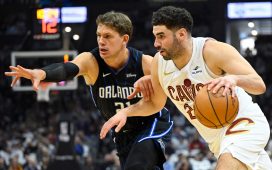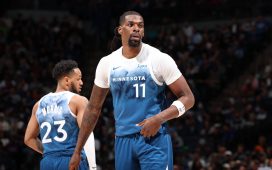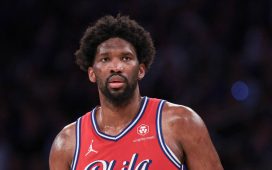So, what exactly constitutes tampering these days? What should constitute tampering? And how will the league’s actions on that front in the coming weeks and months change free agency in the future?
With investigations now underway into the Philadelphia 76ers and New York Knicks, in the wake of last year’s penalties to the Miami Heat and Chicago Bulls that cost each a draft pick, it’s time to take a deeper dive into this issue and where the red lines are.
Let’s start at the top. There are, basically, three kinds of tampering.
The first is the most salacious variety that everyone thinks of when the word “tampering” comes up: A team blatantly contacting another team’s player about future employment, whether directly or via intermediaries, while that team’s season is still going on.
Obviously, there are shades of gray here. You’re allowed to talk to other humans. Players always know people who work for other teams, for instance, and are going to chat up one another before games in those cities. Nonetheless, there’s a pretty clear understanding of the red lines, and virtually everyone who works on the team side agrees no punishment for this offense is too medieval.
The NBA has opened an investigation on the 76ers for potential early contact and tampering, confirmed by @rich_hofmann.
The investigation is focused on the 76er’s free-agency deals with James Harden, P.J. Tucker and Danuel House.https://t.co/1Jbu7C9vAV
— The Athletic NBA (@TheAthleticNBA) July 30, 2022
It’s why many are very interested to see how the league rules on the Knicks’ recruiting of Jalen Brunson from Dallas, where it seems some of these lines might have been crossed.
The issue isn’t just the question of guilt or innocence, but one of how harsh any resulting penalty may be. Will the league continue its recent pattern of penalizing teams a second-round pick, a relatively low penalty they can easily write off as a cost of doing business? That seems like pretty weak sauce when we’re talking about the otherwise free acquisition of star talent.
Or does the league want to pursue more draconian enforcement penalties? In 2019, the NBA mooted executive suspensions and fines, first-round-draft-pick losses and other harsh remedies, but we’ve yet to see any of those steps in practice. The league can also void signings, in theory; in practice, the way the free-agent market works, this is untenable.
The Brunson-esque type of tampering is what fans think of first. However, the league is perhaps equally concerned with two other kinds, and those are both in play with the current investigation into the 76ers. This case is more interesting because it’s an area where the waters are much muddier.
The first of those two tampering categories is probably more aptly called “cap circumvention” than “tampering.” Nonetheless, the league technically considers it the latter since it involves making future agreements with a possible free agent — something that is illegal under the league’s collective bargaining agreement (CBA).
In this case, the issue is that the Sixers agreed to pay James Harden $33 million for the coming season … after he opted out of a deal for $47 million. This, in turn, enabled the Sixers to sign P.J. Tucker and Danuel House to free-agent contracts and still stay below the luxury-tax apron.
The implication of the investigation is that Harden didn’t voluntarily transfer $14 million of wealth to his two former Rockets teammates (it seems particularly unimaginable in the case of House given how that all ended; I’m told Harden wasn’t speaking to House for months afterward) but rather exchanged a lower current-year salary for the promise of a future payout. The CBA forbids that, even with a team’s own player. Harden could re-sign with Philadelphia a year from now on a five-year max worth a potential $270 million, but even amounts well short of that figure could arguably be an overpay based on the decline he showed in his age-32 season in 2021-22.
This may seem like semantics to most fans, but the league takes cap circumvention of this type quite seriously. Ponder a more egregious example (I’m not saying this has any chance of happening, I’m just offering a scenario of blatant cap circumvention) where, say, LeBron James plays for the minimum next season so the Lakers can sign two max free agents to join him and Anthony Davis, then re-ups with Bird rights for a full max deal a year later. The entire league would scream bloody murder and rightly so.
The problem for the league is that it may not have a smoking gun here; the underlying problem with most tampering cases is that proving it depends heavily on the clumsiness of the offending front office. In the absence of a signed agreement hiding in a desk, the only truly smoking gun would be if Harden had a bad 2022-23 and the Sixers paid him handsomely anyway … in which case the contract might be a greater penalty than whatever the league office could do.
What’s interesting here is that if the league is looking at Harden’s case, does it want to look at others that implied a similar wink-and-a-nod toward future payouts? For instance, of less fishiness but still somewhat redolent of sardine, are arrangements such as Nic Batum’s with the Clippers or Bobby Portis’ with the Bucks.
Each signed a below-market one-year deal to stay with their respective teams in 2021 then re-signed via early Bird rights at his maximum allowable annual salary (two years, $22 million for Batum; four years, $49 million for Portis). Those aren’t the sole instances of such deals. Recent annals provide other examples that may be fishy or may be the innocent result of circumstance. (Bucks and Clippers fans will argue that Portis and Batum wanted to return, but that misses the point. The issue is whether the promise of a future payout made that possibility more viable versus turning down more present money elsewhere.)
One interesting takeaway from the Harden investigation, then, is where does the league care to draw the line? I’m not sure people in the league are all that upset about the type of deals Batum and Portis signed. Up to this point, the league has shown little inclination to investigate similar cases.

People are interested in how the league rules on the Knicks’ recruiting of Jalen Brunson from Dallas. (Andy Marlin / USA Today)
On the other hand, I can imagine people in Miami in particular are rather upset about the Sixers’ deal with Harden. The Heat could have evaluated the market heading into the offseason and reasonably believed they could keep Tucker at $8.4 million a year (the maximum amount allowable by the Heat without incurring the luxury-tax apron), not anticipating a $14 million pay cut for Harden that permitted the Sixers to start Tucker at $10.49 million per annum.
Speaking of Miami, that takes us to the final type of tampering. This is the variety that cost the Bulls and Heat draft picks a year ago and the Bucks a year before that: jumping the gun before free agency officially begins. It may cost the Sixers as well, given how early the rumors came out that Tucker would be leaving for Philadelphia.
This type of tampering, frankly, is the least offensive to most executives. If you polled them, the general consensus would be, “What the hell did you want us to do?” News flash: Free agency is 90 percent done by the time it allegedly starts. Virtually every player of significance had a deal announced in the first 36 hours this year. Many of those announcements, no doubt, were still foot-dragged to provide the cover of plausible deniability.
I’ll note that this is a recent shift, and it wasn’t always like this. When I started working for Memphis, players wanted to spend the first few days of free agency meeting with teams and be wined and dined, especially the superstars. Because those dominoes needed to fall first, it slowed the entire pace of free agency. Usually, there was enough time to do things more-or-less on the up-and-up.
Over the course of my seven seasons with the Grizzlies, that radically changed, and that pattern has only worsened. Toward the middle of the last decade, one prominent agent, in particular, realized he could get very good deals for his mid-tier players if he negotiated them before the starter’s pistol went off, and others quickly followed.
Meanwhile, players stopped worrying about meetings and spent more time figuring out how to team up with each other. The idea of dog-and-pony show “meetings” with potential free agents — here’s a gaudy PowerPoint, here’s a jersey, here’s our coach‘s spiel on how he’ll use you, look we even brought our owner and our third-best player so you know we’re serious — now seems like a quaint relic of a bygone era.
To my knowledge, there hasn’t been a full-bore recruiting meeting like this since Gordon Hayward’s tour of Miami and Boston and Clipper-for-life Blake Griffin’s summit with L.A., both in 2017. Chris Paul changed the landscape a year later by telling the Clippers before free agency started that he was going to Houston. Now, if a team waits until 6 p.m. on June 30 to contact potential free agents, it’s crashing a party that’s already over.
This makes the league’s current stance on this type of tampering hard to pin down. At the moment, I’d describe the policy as “just don’t embarrass us.” If you want to wrap up free agency on June 27, that’s fine, but keep it on the down-low, please. Don’t spike the ball in our face by announcing a complicated sign-and-trade in the first four minutes of free agency. (Or days before it, in the bizarre case of Bogdan Bogdanović.)
Nonetheless, the league’s stance in all three areas still appears to be evolving. Despite well-intentioned rules written on paper, there remains too much haziness in practice. Those rules have taken on added significance in the last half-decade as free agency has turned into a speed round of musical chairs; it is no longer realistic for teams to operate by the letter of the law.
Thus, the fallout from both the Sixers’ and Knicks’ cases will have important implications for how teams conduct free-agent business in the coming seasons.
One can only hope the conclusions and precedents the league sets from these investigations are clear enough for everyone to recognize where the lines are going forward, as well as the costs. Right now, we’re still guessing.
Related reading
Katz: Jalen Brunson signing creates blurred lines for Knicks
(Top photo of James Harden and P.J. Tucker: Michael Reaves / Getty Images)








